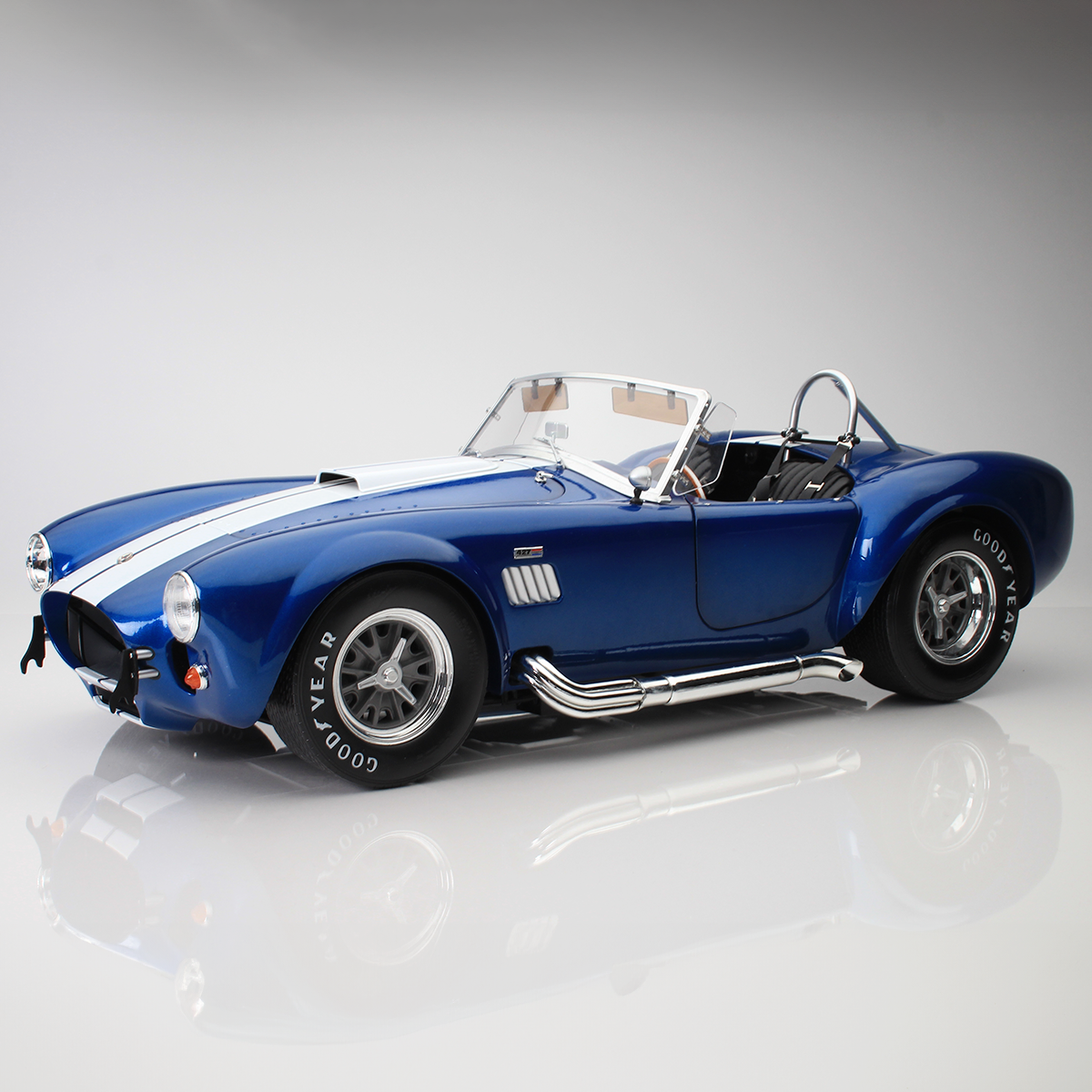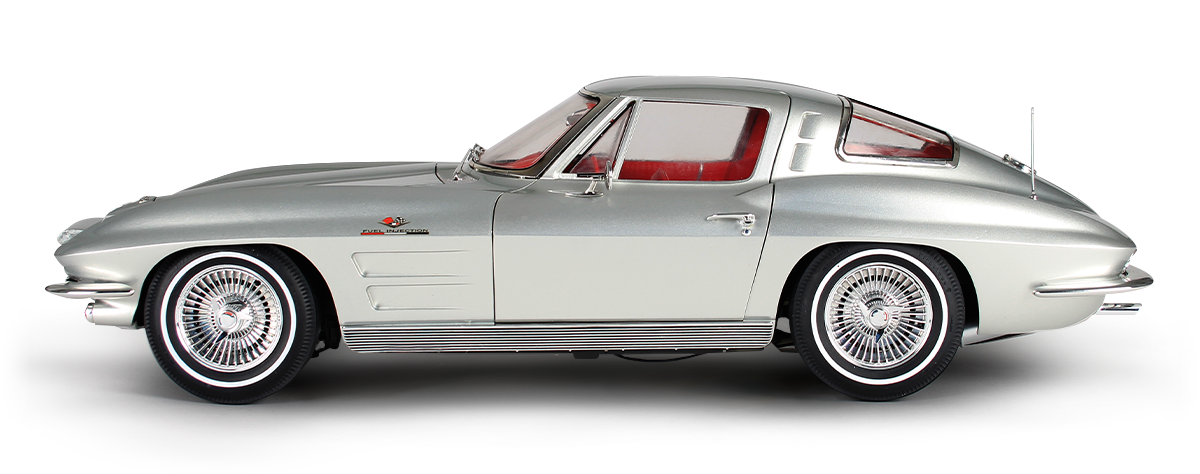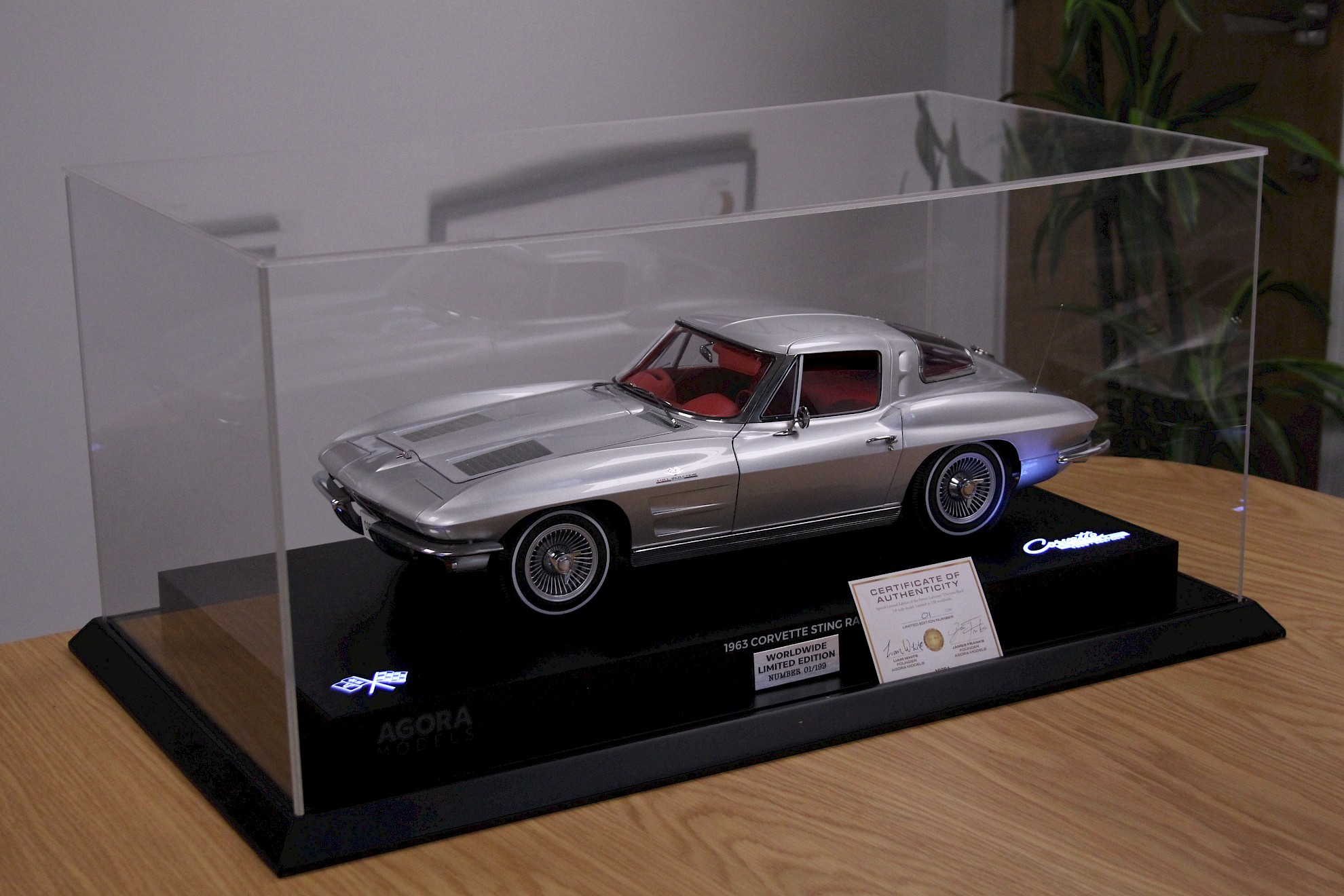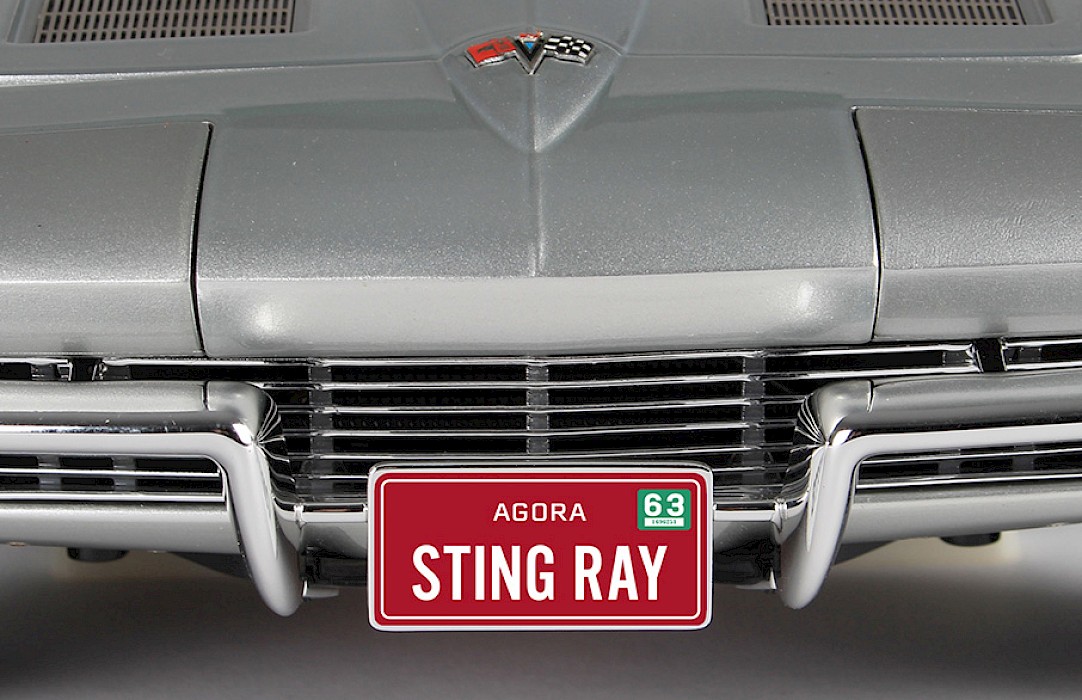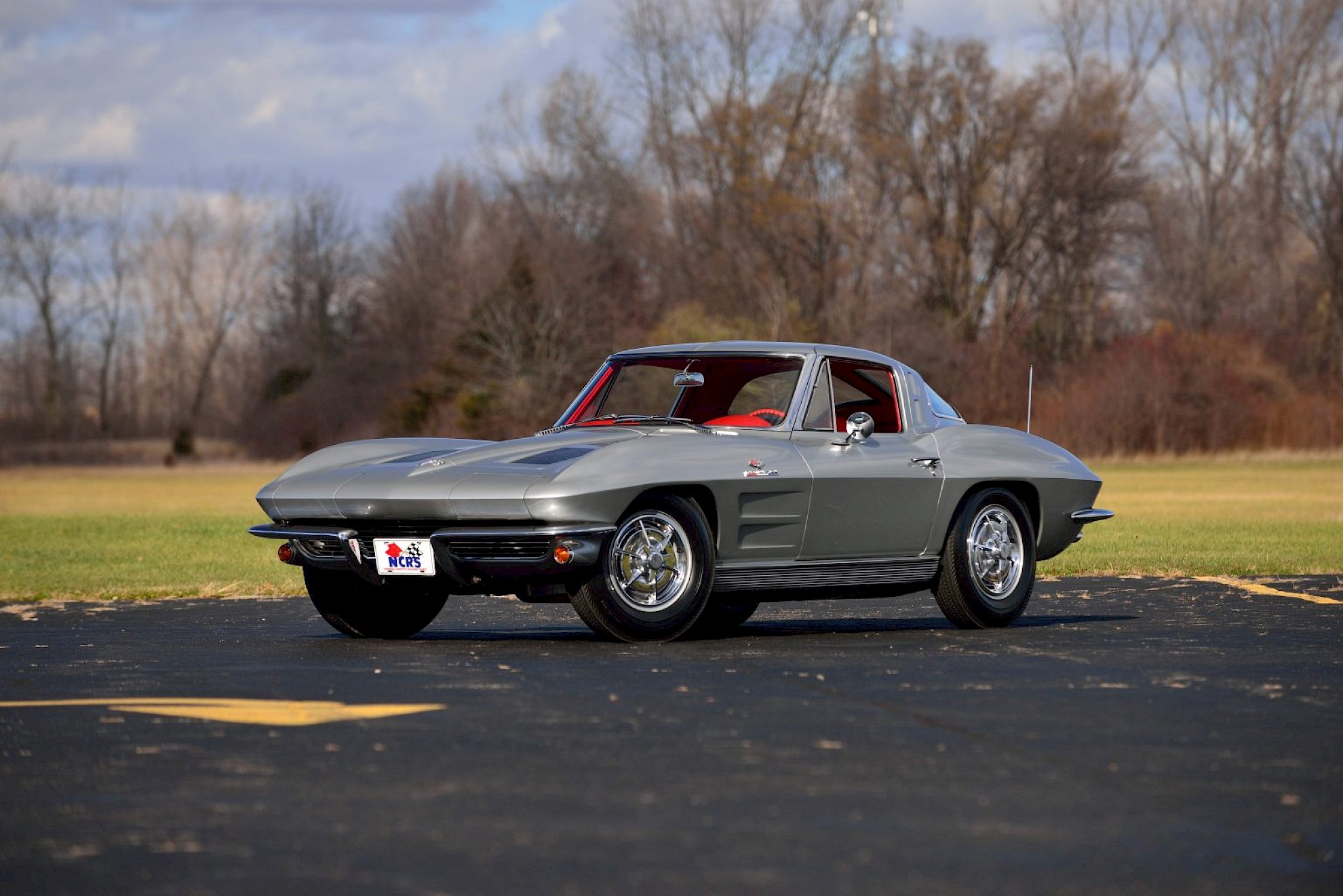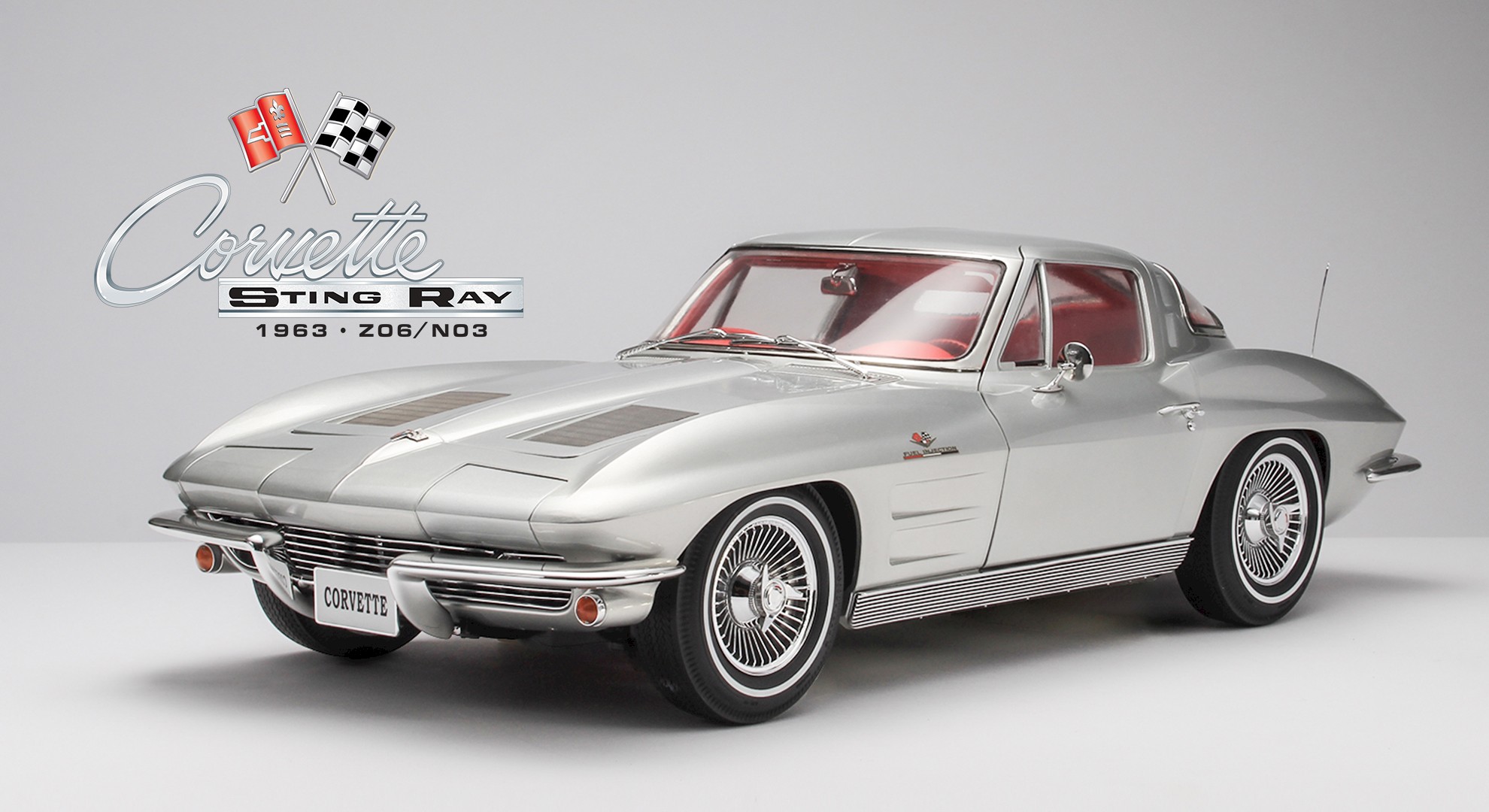
The most collectible Corvette of all time
The 1963 Corvette Sting Ray marked a new direction for sports cars in America.
The sleek design, impressive handling and a powerful V8 made it both capable and desirable when it was released to the world. When coupled with the one-off split rear window of the 1963 model, the Corvette Sting Ray is now one of the most desirable additions for car collectors worldwide.
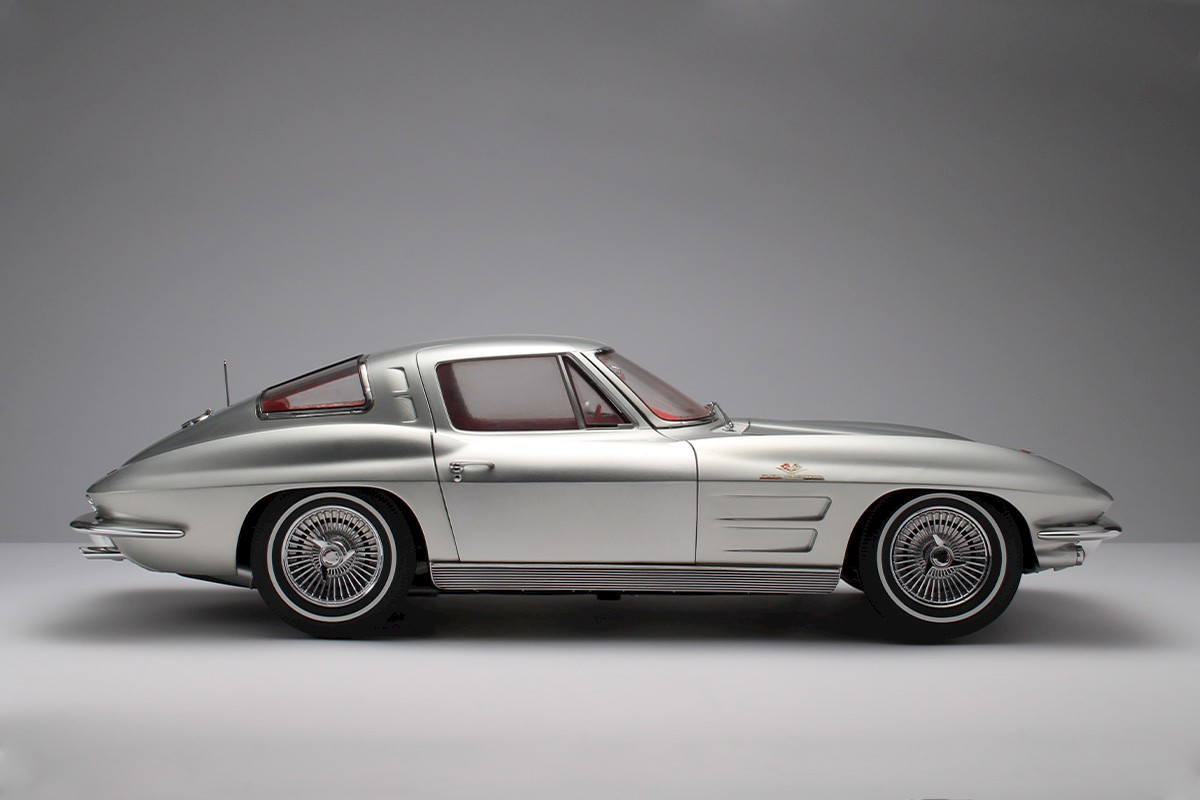
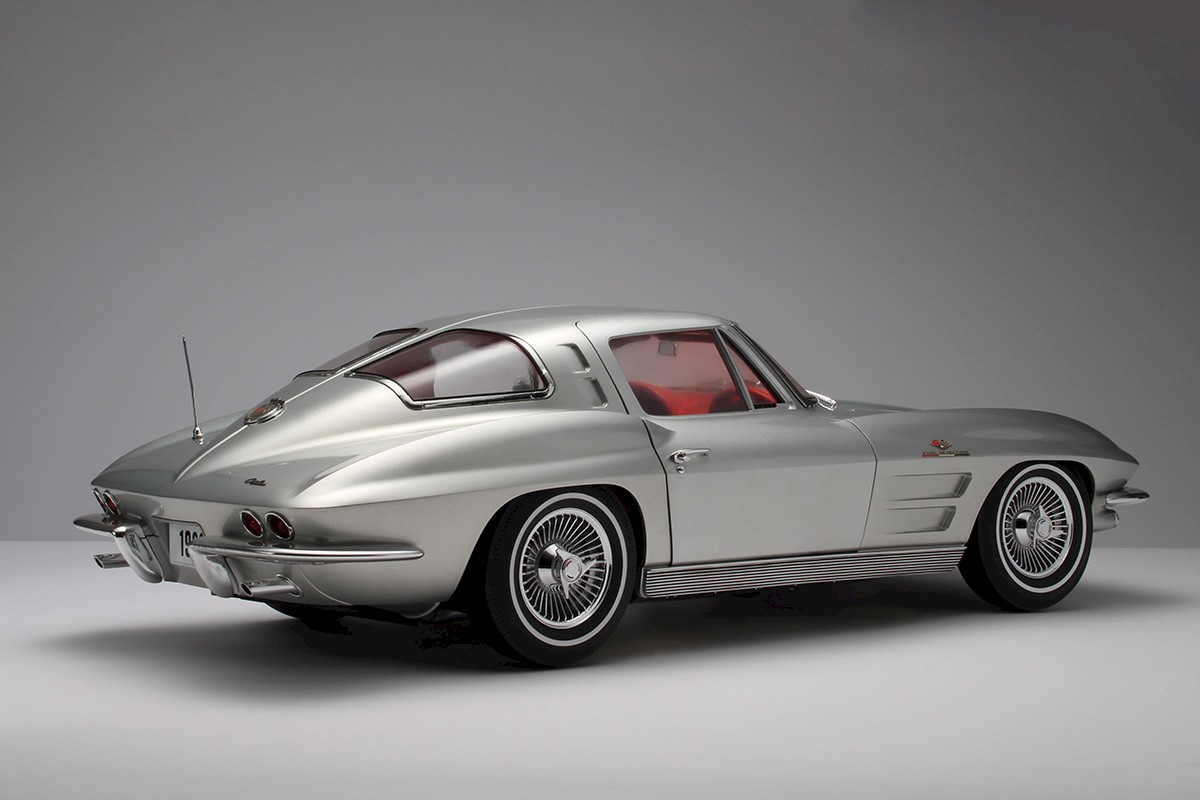
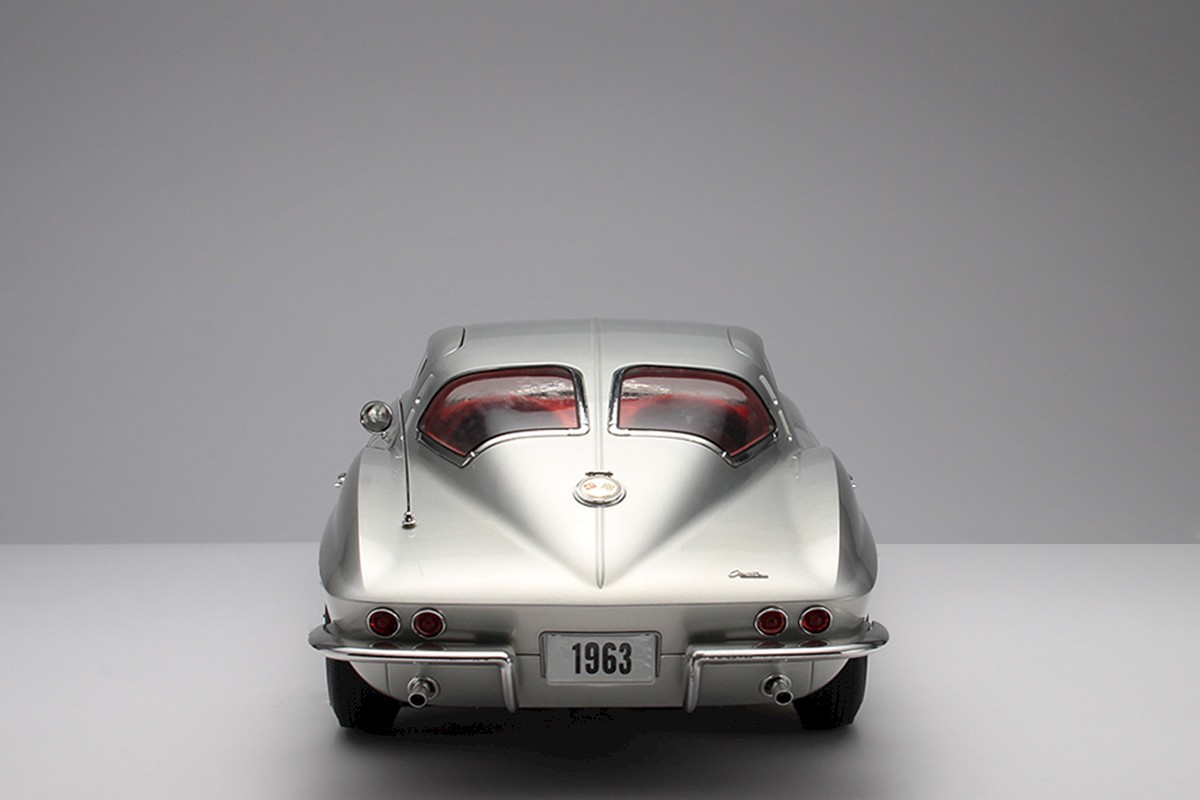
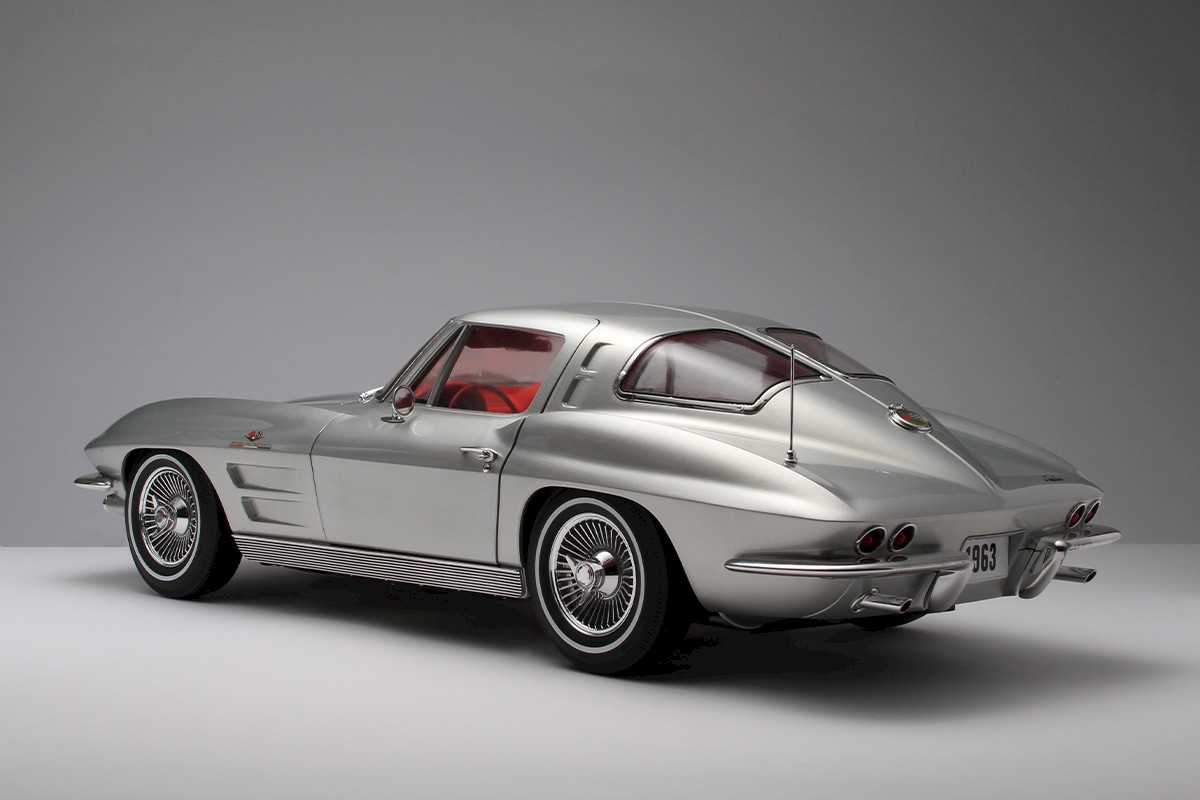
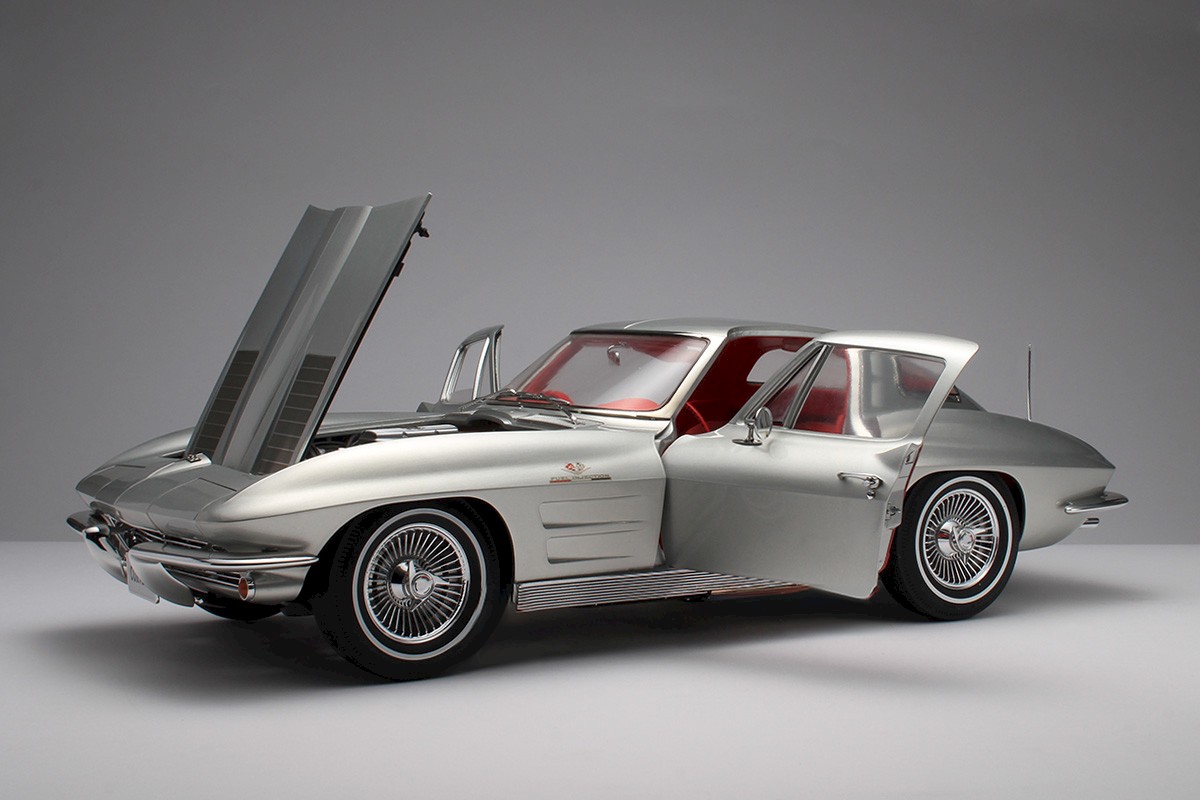
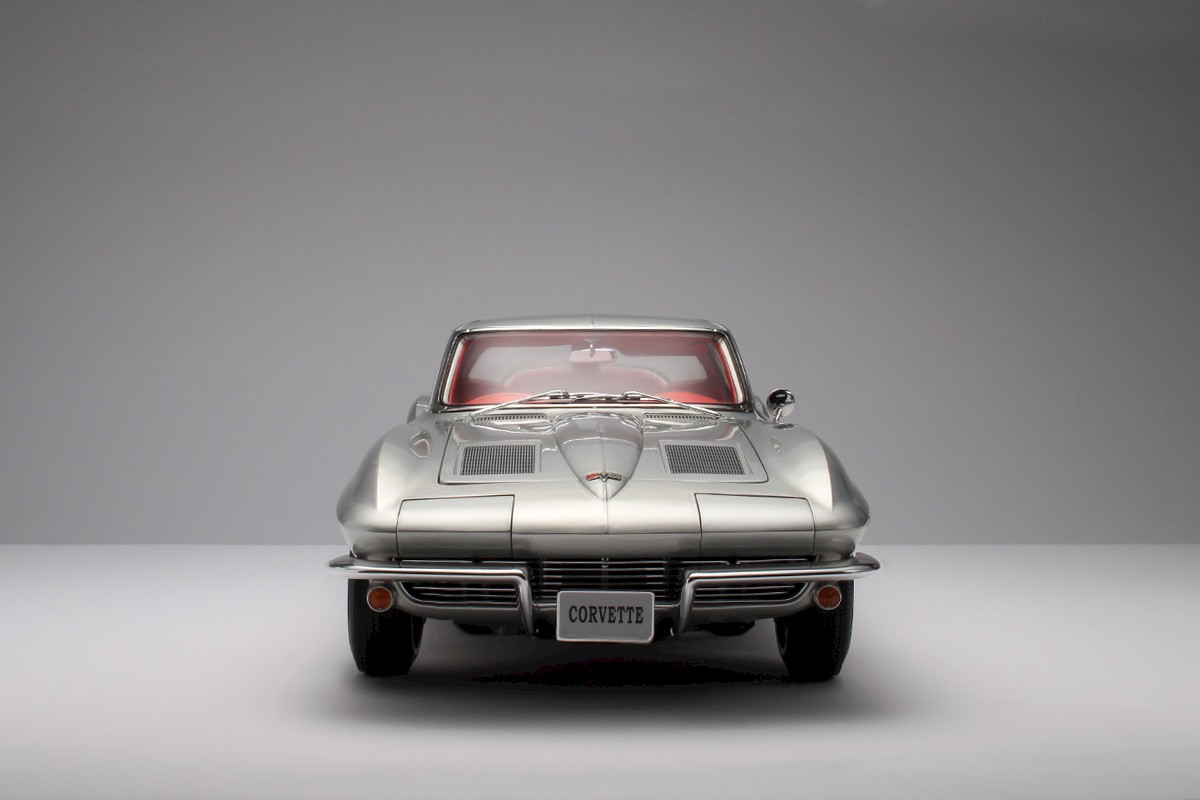
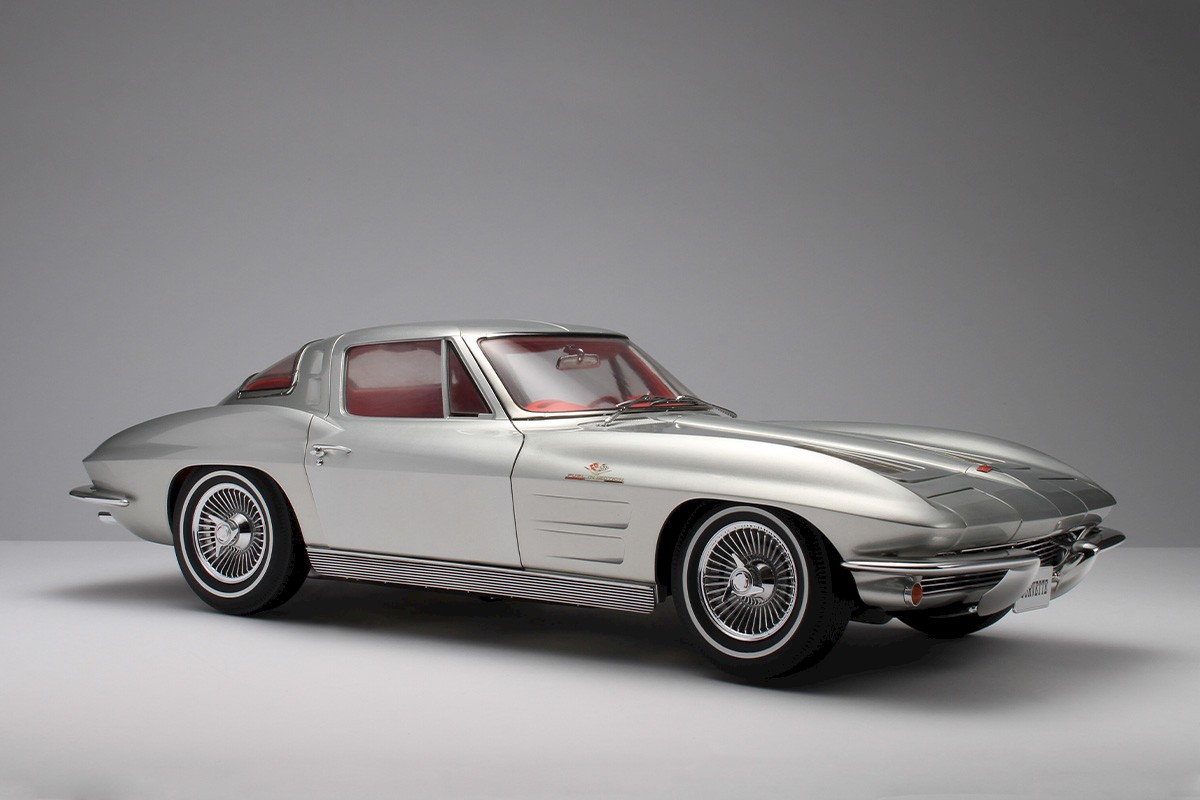
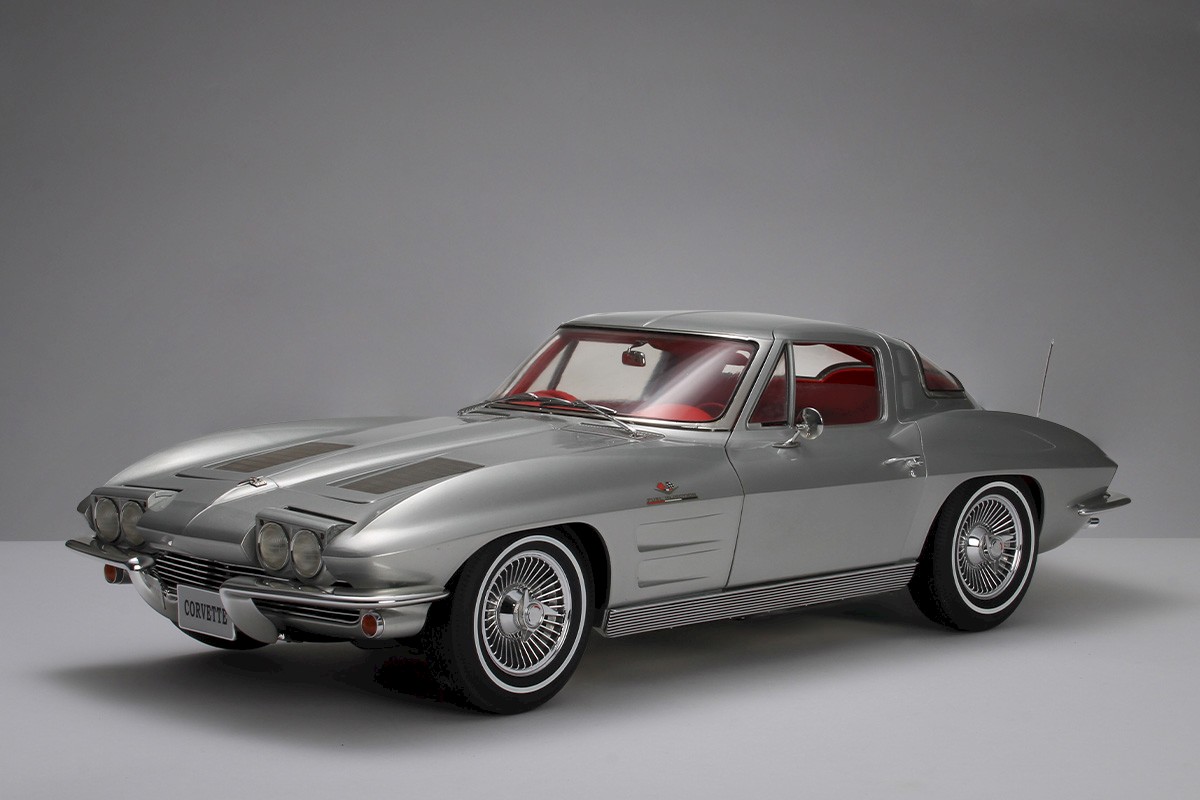
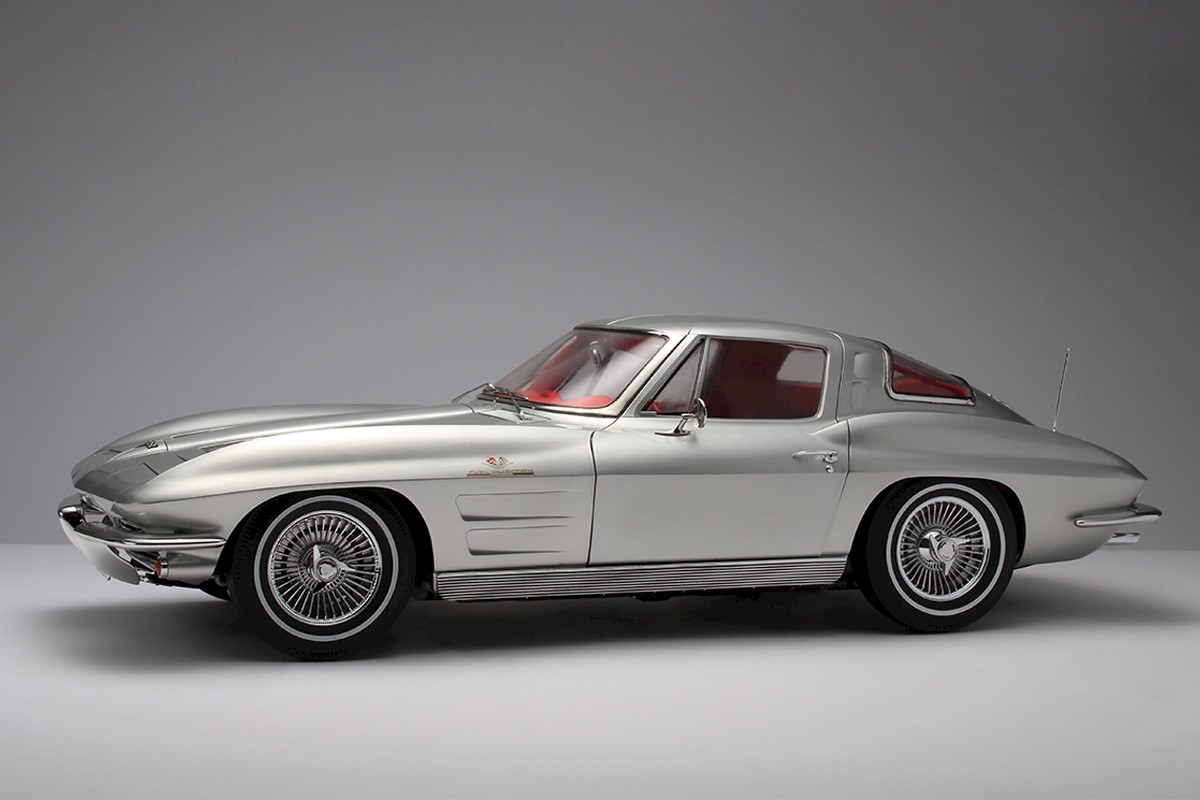
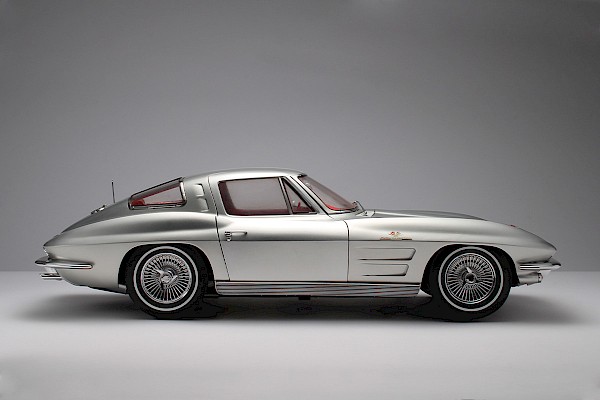
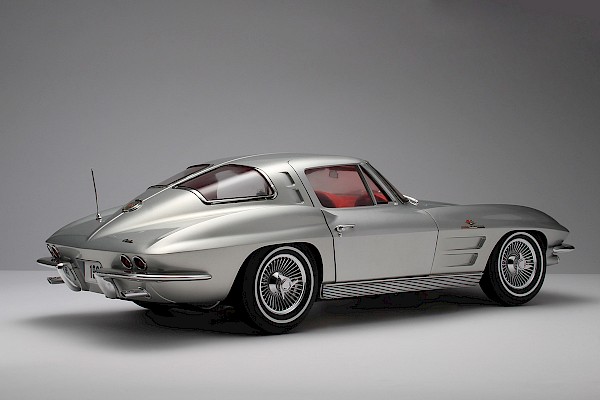
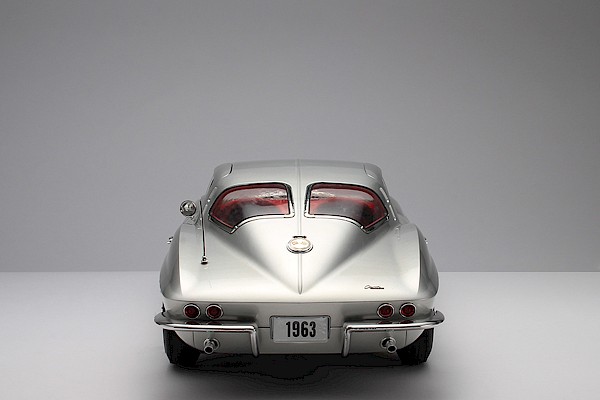
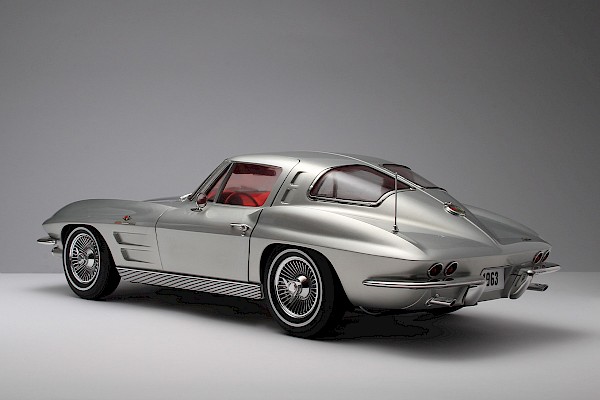
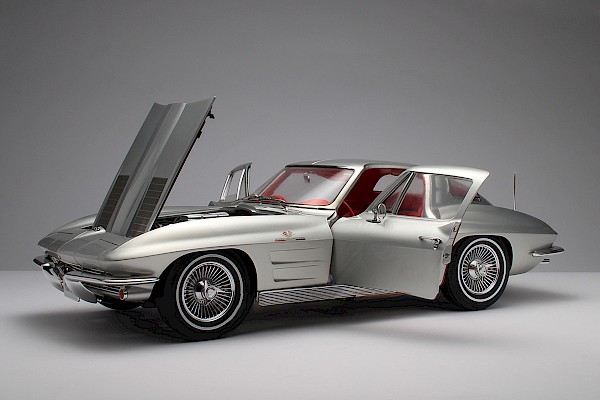
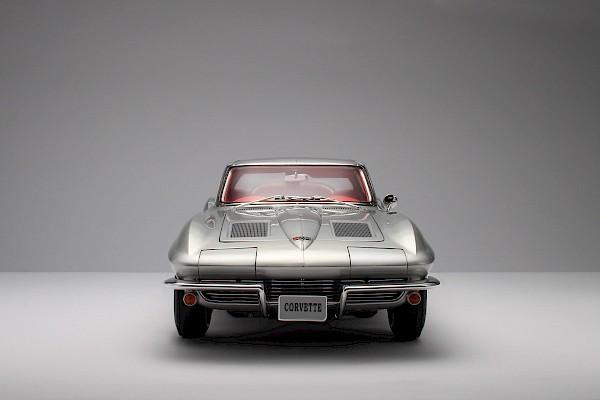
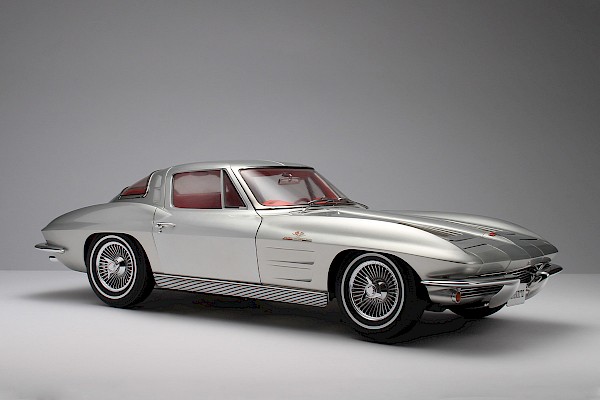
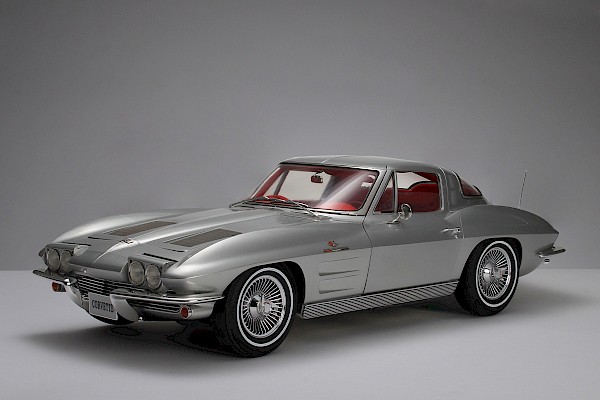
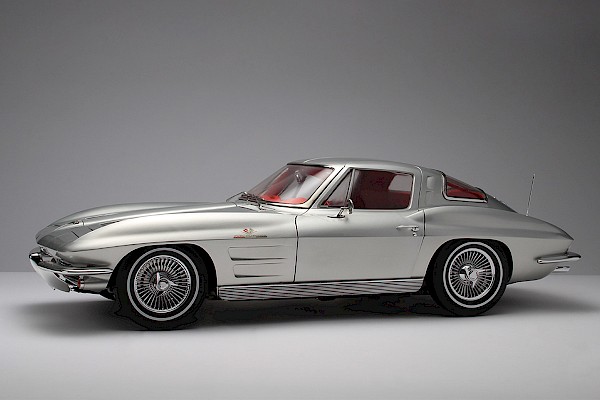
Specification & Features
Your exquisitely detailed 1963 Corvette Sting Ray
At 1:8 scale, this museum-quality reproduction includes all the design elements that were unique to the '63 model, most notably the split rear window and non-functional front grilles on the hood. The detailed V-8 engine that gave 360 horsepower is assembled using 130 parts alone, making it a museum-worthy piece in its own right.
This model is the ZO6 NO3 (big tank) option - built to go racing and which took performance of the '63 Corvette to a new level. No wonder Olympic sprinter Michael Johnson has owned every Corvette ever made with the big tank option!
Finished in Sebring Silver paintwork, the interior detailing includes stunning red bucket seats and dashboard details featuring the optional AM/FM radio.
Electronic functions include remote controlled rotating headlights, illuminated dashboard, and working lights – including indicator lights with original '63 sound effect.
Choose between two wheel options, both included: replica '63 steel wheels and '64 aluminium turbine wheels with knock off centre caps.
General Motors built just 199 ZO6 Corvettes in 1963, and only 63 of them were big tank cars. This faithful reproduction provides a unique opportunity to recreate and enjoy one of the world's most coveted cars.
Specifications
- Scale: 1:8
- Material: Body and chassis made from zamak metal
- Length: 550 mm (21 1/2”)
- Width: 230 mm (9”)
- Height: 160 mm (6 1/2”)
- Weight: 7kg
Number of parts: 500 approx.
Features
- Hand-held RC to operate electrics
- Electronically rotating headlights
- Working indicator lights with sound effect
- Engine sound
- Illuminating stop lights
- Illuminated dashboard
- Steering wheel operates the front wheels
- Opening hood, wrapover doors, windows, and gas-filler tube cover
- Sebring Silver body with red interior
- Two sets of wheels included:
’63 or ’64 knock-offs - Concealed spare wheel in storage rack
Video
Timelapse video
Alex builds the complete model in 10 minutes!
Pack 1 build video
World of Wayne
It's all in the detail
Outstanding detail at 1:8 scale
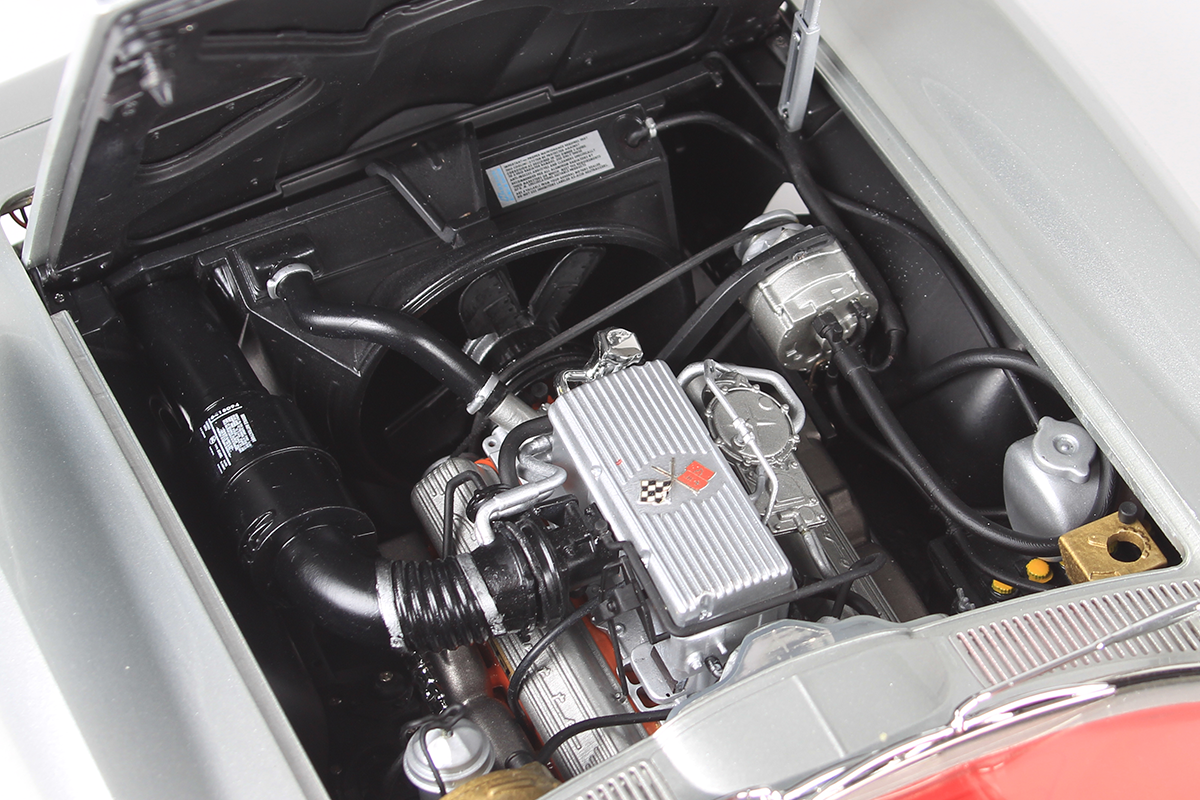
AUTHENTIC ENGINE
Hood opens to reveal the authentic 327 engine
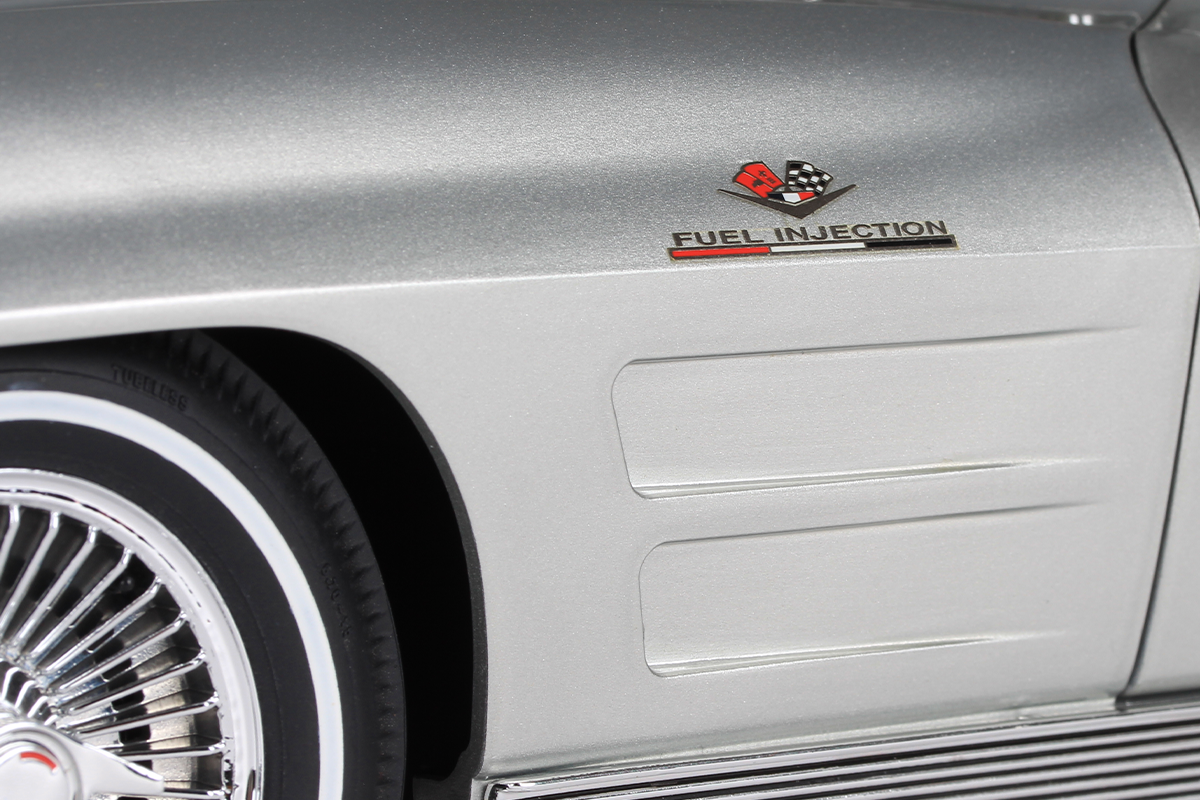
DIE CAST METAL PARTS
Made from high-quality materials including die-cast metal, photo-etched and ABS parts
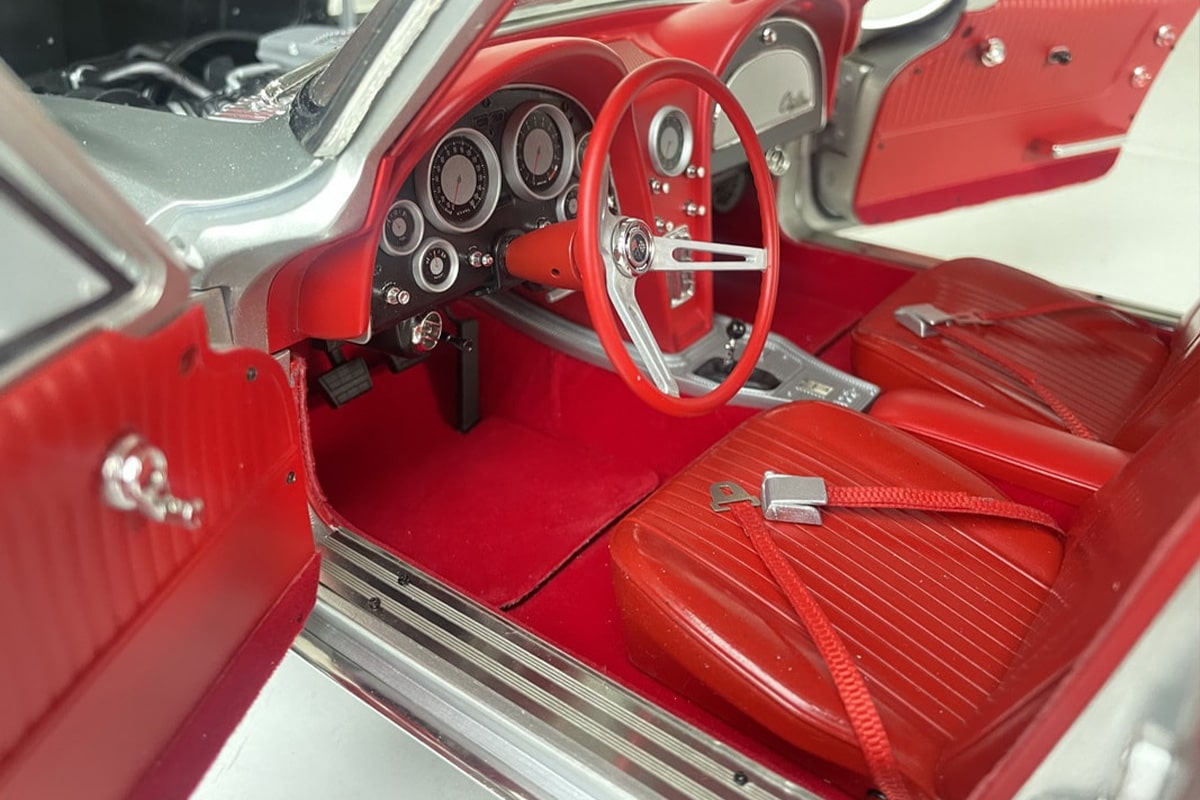
OPENING DOORS
Opening doors, hood, and gas-filler tube cover
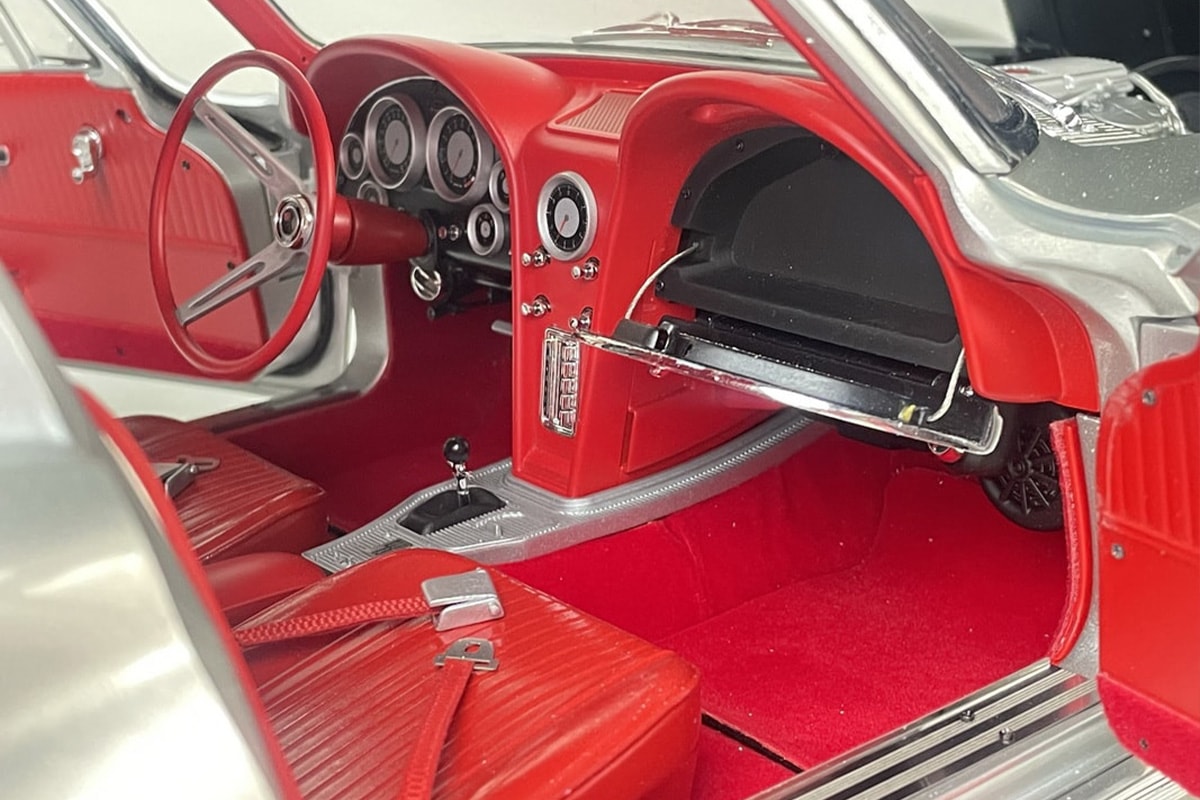
INTERIOR DETAIL
Highly realistic dashboard with detailed dials and levers
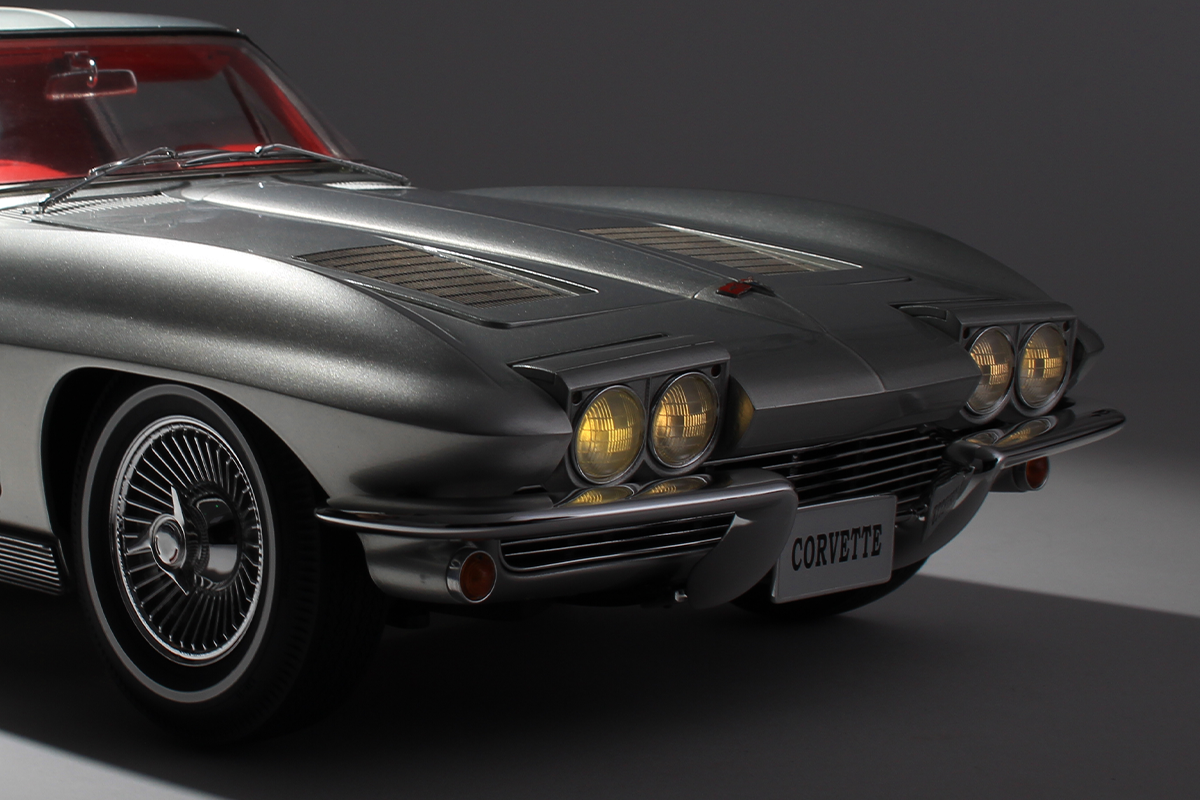
ROTATING HEADLIGHTS
The headlight buckets rotate to open and light up
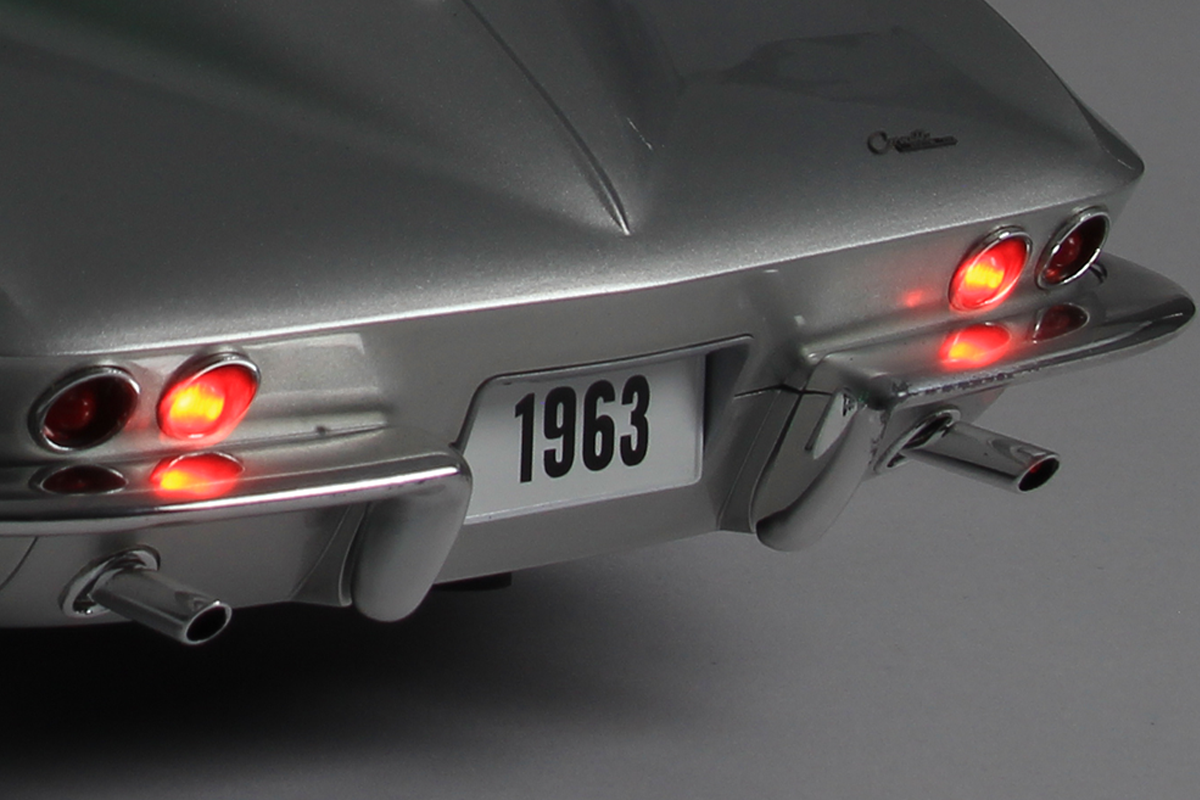
WORKING ELECTRICS
Illuminating headlights, taillights and interior
You also get…
As part of this model, you will also receive:
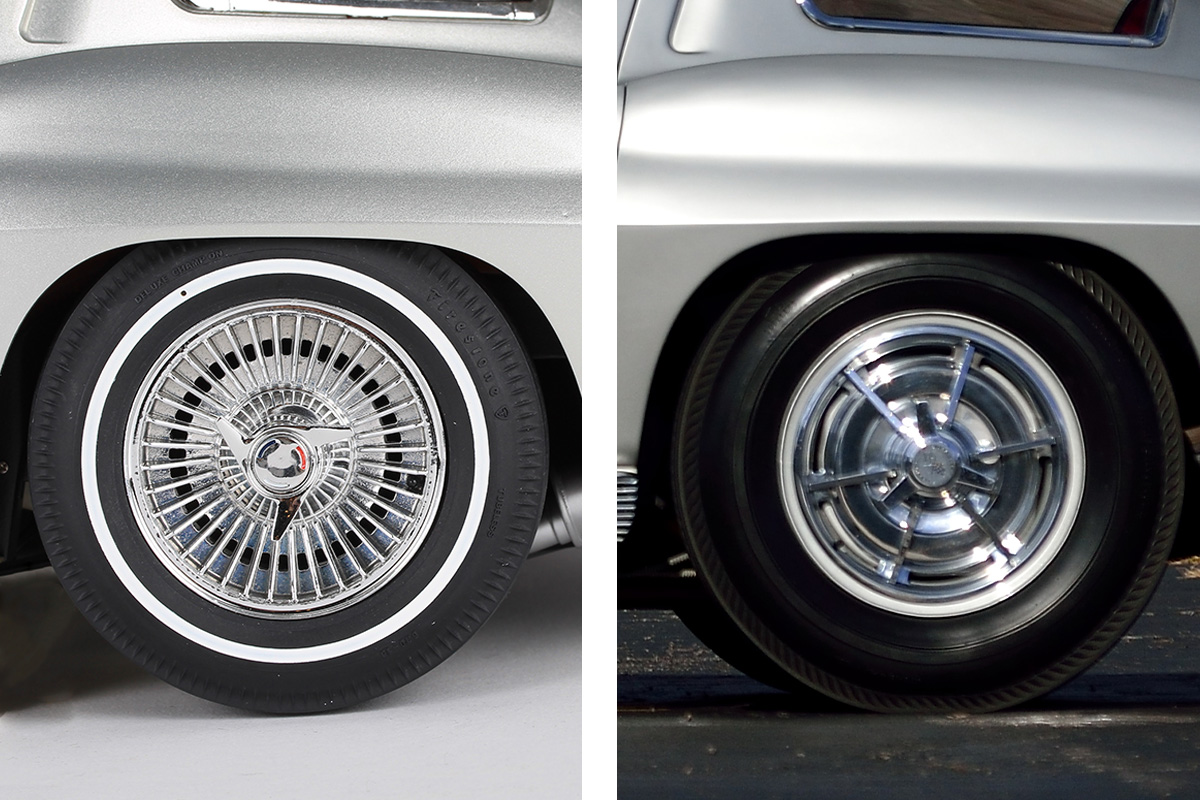
Two complete tire sets
The Sting Ray is often seen sporting knock-offs which, although specified for ’63 production models, were not available until 1964. This model comes with five original 1963 wheels PLUS five 1964 knock-offs, so you can decide which set to use!
Upgrade to the Limited Edition
To celebrate the exclusive launch of this legendary classic Sting Ray, in addition to the standard 1:8 model, Agora Models is offering a Limited Edition featuring an illuminated display plinth and protective display case.
(strictly limited to 199 worldwide)
** SOLD OUT **
Your Limited Edition 1963 Sting Ray comes on this beautiful, show-quality plinth, featuring the iconic Corvette logos. As part of a limited production run, your display plinth will be individually numbered 1–199.
The Limited Edition is now sold out
Your buying options
When you place your order we will send your first pack with the first stages of the kit to build your model. Following this, you will be sent another pack every month for 11 months. You will be charged monthly.
Alternatively, you may choose a Full Kit, Accelerator or the 24-month plan – click here for more details.
This model can be purchased with a display case.
Select the “Model + Case” option to include this with your purchase.
We ship worldwide

PACK 1 ONLY {pricepack1}
then {price} per month
Add £12.50 per month to include Display Case

PACK 1 ONLY {pricepack1}
then {price} per month

PACKS 1–6: {priceaccelerator}
then {price} per month

PACKS 1-12: {priceaccelerator}
Get the Full Kit!
The 1963 Corvette C2 Sting Ray
Corvette Sting Ray History
The Corvette C2 was the second generation of Chevrolet’s sports car, following on from the C1. It became popularly known as the Corvette Sting Ray and was unlike anything Corvette had released before.
The development of the new Sting Ray was influenced by various projects. Notably, the 1957 racing car Stingray which had been developed by Larry Shinoda and Peter Brock for chief stylist Bill Mitchell. Peter Brock’s initial sketches were of a coupe and an open-topped roadster. While the roadster sketch was used for the Stingray racer, when development began for the C2 the coupe sketch was refined into what would become the 1963 Sting Ray.
One of the new features for the new generation of Corvettes would be its availability as a coupe – the previous generation had only been sold as a convertible. The car was futuristically styled with a streamlined body and, most notably, had a split window – two panes of glass separated by a narrow space. This made the 1963 model particularly special, as the split-window would be removed in favour of a traditional single-pane window for the 1964 edition – one of the many reasons why the original model is so highly sought after by collectors today.
The Sting Ray featured a 327 cubic-inch small-block V8 engine that provided 250 horsepower, with the optional versions that could offer 300 hp, 340 hp, or the 360 hp of the fuel-injected Rochester engine. Although the brochure promised the availability of aluminum knock-off wheels – as seen on some of the pre-production models – they were not ready by the time the car launched. Instead, original customers of the 1963 model had steel wheels with six-ribbed hub caps fitted. Eventually, the aluminum knock-offs were made available in 1964 for $322.
General Motors (GM) had a racing ban in place which stopped its brands offering track ready cars. Despite this, Chief engineer for Corvette, Zora Arkus-Duntov, designed the Z06 package for the new 1963 model (some suggest the “Z0” in the name refers directly to “Z0ra”). Those customers who specified a need for a “fuelie” would get everything they’d need to maximise the performance of the new car: the fuel injected small-block V8 provided 360 hp coupled with a close ratio 4-speed transmission; the dual-circuit master cylinder and brakes with sintered metallic linings and fins reigned it in for the corners; while a bigger front stabilizer bar, stiff springs and larger shock absorbers could withstand the rigours of the track. Those who added the N03 option – a larger 36.5 gallon fuel tank – would see the benefit in endurance racing.
These options were not cheap: a base model coupe would set you back $4,257 in 1963 while the Z06 upgrade package with the N03 tank would add nearly an extra 50% to the price, costing $2020 ($1818 for Z06 and $202 for N03). In all, only 199 cars were given the Z06 upgrade, 15 of which were sent to racing teams. Fittingly, there were only 63 cars sold with the N03 tank, making the combination of a Z06/N03 “Big Tank” Sting Ray a rare find – especially when so many were raced and inevitably lost to wear or crashes! It is estimated that only 50 Corvette Sting Ray Z06/N03 are known to still exist.
When combining so many rare elements – the split rear window of the 1963 model, with the obscure upgrade of the Z06 package and the optional addition of a “Big Tank” for endurance racing – it’s easy to see why a Corvette Sting Ray Z06/N03 is so sought after by collectors today.
Technical Specification
Car type: Two-seater coupe
Dimensions: 445.3 cm (175 5/16 in) long, 176.8 cm
(69 5/8 in) wide, 125.2 cm (49 5/16 in) high
Kerb weight: 1377 kg (3036 lbs)
Wheelbase: 248.9 cm (98 in)
Power: 360 bhp
Torque: 351 lb-ft (477 Nm) at 6000 rpm
Engine type: Small Block 327 V8,
Rochester fuel-injection
Displacement: 5354 cc
Transmission: 4-speed manual
Layout: front, longitudinally mounted
Top speed: 147 mph (237 km/h)
0-60 mph: 5.7sec
Corvette C2 Sting Ray Trivia
According to some, Corvette’s chief stylist Bill Mitchell returned one day from a fishing trip in Bimini, the sport fishing capital of the world, with a taxidermy Mako shark he had caught. With the Sting Ray launch still a time away, he decreed that a new show car was needed and that the shark would be a perfect theme for it – including the colour of the Mako. The XP-755, dubbed the Mako Shark, took design elements from the Sting Ray, but its color was an arduous task for the paint team to replicate from the shark. With Mitchell insisting the two must match and after numerous failed attempts, the paint crew supposedly kidnapped Mitchell’s fishing trophy and simply sprayed it to mirror the car!
Zora Arkus-Duntov also developed the Grand Sport Corvette using the Sting Ray, a secret project born from a desire to compete in racing with Ford and the Shelby Cobra. This model was designated the “Lightweight” as the team behind it cut as much weight from the production model as possible. An aluminum cage replaced the standard steel version, with thin fiberglass body panels and magnesium-cast wheels bringing the weight down by 1000 lbs. Although 125 were planned, when budget-minded GM executives discovered the project, it was shut down with only 5 models ever produced.
Sting Ray or Stingray? The original racing car of 1959 was developed officially as the XP-87 and given the aquatic moniker “Stingray” by deep-sea fishing enthusiast Bill Mitchell – the racing ban prevented it being identified as a Corvette. The C2, however, was released with the badge “Sting Ray”, which persisted throughout its lifetime from 1963 to 1967. Fast forward to the third generation C3, it was back to “Stingray”. By 1976, the name had disappeared entirely – until the release of the seventh-generation Corvette in 2014, again as “Stingray”.
Although his sketches would eventually become the 1963 Sting Ray, Peter Brock left GM in 1959 to pursue a career in racing. In 1961, he became the first paid employee of Carroll Shelby when hired to run the Carroll Shelby School of High Performance Driving. He worked at Shelby American until 1965, designing the logos, merchandise, ads, and car liveries, as well as components and bodies for various Shelby cars including the 1964 Shelby Daytona Cobra Coupe.
Archive footage from Corvette of the Sting Ray
Watch this short featurette of the 1963 Corvette Sting Ray
You may also like...
